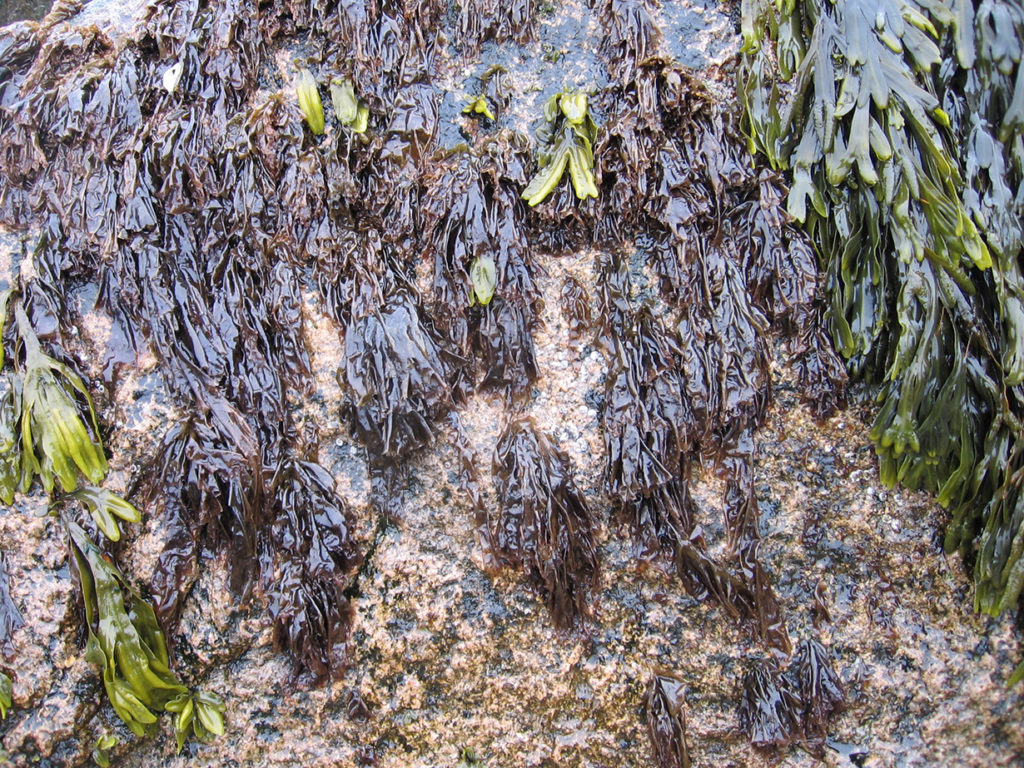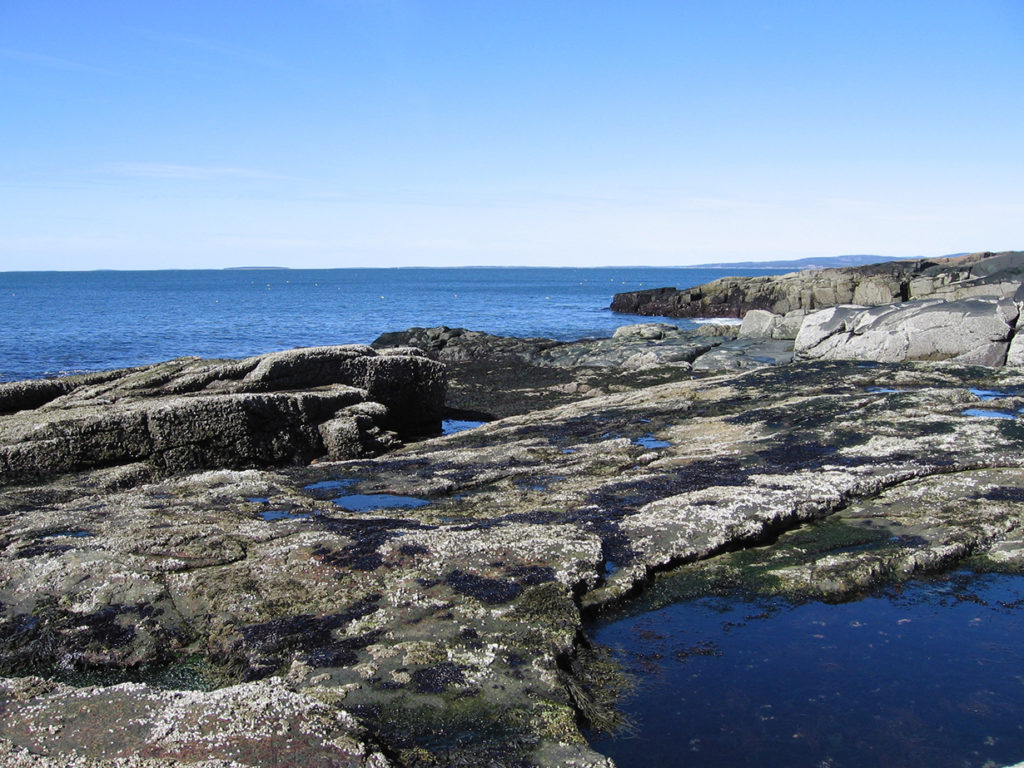The genome of Porphyra umbilicalis reveals the mechanisms by which it thrives in the intertidal zone
The Science

Porphyra umbilicalis (laver) attains high biomass despite the high levels of stress in its habitat in the upper intertidal zone of the North Atlantic, as shown here at low tide at Sand Beach, Acadia National Park, Maine. (Susan Brawley)
Through the Community Science Program of the U.S. Department of Energy Joint Genome Institute (DOE JGI), a DOE Office of Science User Facility, a 50-member team led by University of Maine, Carnegie Institution for Science, and East Carolina University researchers sequenced and analyzed the genome of Porphyra umbilicalis, a red alga that is thought to represent one of the oldest forms of marine life and the origin for diatoms and other photosynthetic microorganisms.
The Impact
Though red algae are one of the oldest multicellular lineages, only a few have had their genomes sequenced. Porphyra umbilicalis is found in the ocean’s intertidal zone, and is subject to constantly changing environmental conditions including temperature, light, and desiccation levels. Analyzing the alga’s genome lends insights into its stress-tolerance mechanisms and how that impacts its ability to fix carbon. As diatoms and other photosynthesizing microorganisms evolved from red algae, red algae metabolism had a significant impact on the planet’s carbon cycle. The team found strong cytoskeletal limitations in Porphyra and most other red algae with sequenced genomes, offering a possible explanation for why red algae tend to be small compared to other multicellular eukaryotes.
Summary

Scattered dark patches of Porphyra umbilicalis in the upper intertidal zone at Schoodic Point (Maine), on a calm, sunny day that will expose this ubiquitous North Atlantic red alga to high light and drying stresses. (Susan Brawley)
The intertidal zone is the area between land and sea that is sometimes concealed by high tide or revealed by low tide. As this ecosystem is in constant flux, the organisms that inhabit the area have adapted to thrive under a range of constantly changing environmental conditions. Porphyra and other genera of bangiophyte red algae thrive in the intertidal zones of the northern and southern hemispheres. Their lineage is ancient, and the oldest taxonomically resolved fossil of a multicellular eukaryote, 1.2 billion years old, was also a bangiophyte. The green algae and red algae are both groups of plants that carry out photosynthesis using light-harnessing organelles called chloroplasts, which evolved from cyanobacteria that were engulfed by the ancestral eukaryotic algae. Later, other environmentally important algae such as diatoms, dinoflagellates and haptophytes evolved when other non-photosynthetic eukaryotes captured red algae and integrated the red algal chloroplast and red algal nuclear genes into their genomes. These processes greatly diversified the organisms capable of conducting photosynthesis, and the red algal imprint on global productivity, aquatic food webs, and oxygen production is significant.
As reported in the Proceedings of the National Academy of Sciences, the DOE JGI sequenced, assembled and annotated the genome of the red alga Porphyra umbilicalis to better understand how it harvests light and nutrients, and how warming oceans might impact its ability to fix carbon. The team led by University of Maine researchers found that the red alga has previously unrecognized means of tolerating its physically stressful intertidal habitat. For example, Porphyra umbilicalis has multiple strategies to protect cells from being damaged by high light levels, including expanded families of proteins that protect the photosynthetic apparatus from high light and unusual genomic arrangements of the genes that synthesize the mycosporine-like amino acids that protect against ultraviolet light. They also found that the alga has a significantly reduced cytoskeleton and lacks many motors other organisms rely on for intracellular transport. This may explain why red algae, compared to many other multicellular eukaryotes, are smaller and less structurally complex and how they can survive, in the closing words of the publication, “in the pounding waves, baking sun, and drying winds of the high intertidal zone.”
BER Contact
Daniel Drell, Ph.D.
Program Manager
Biological Systems Sciences Division
Office of Biological and Environmental Research
Office of Science
US Department of Energy
daniel.drell@science.doe.gov
PI Contacts
Jeremy Schmutz
Plant Program Head
DOE Joint Genome Institute
jschmutz@hudsonalpha.com
Susan Brawley
School of Marine Sciences
University of Maine
brawley@maine.edu
Funding
Work was conducted by the U.S. Department of Energy (DOE) Joint Genome Institute, a DOE Office of Science user facility (contract number DE-AC02-05CH11231). This work was also supported by the National Science Foundation, National Oceanic and Atmospheric Administration (NOAA), German Research Foundation, French National Research Agency, US Department of Agriculture/National Institute of Food and Agriculture, Biotechnology and Biological Sciences Research Council and European Union FP7 Marie Curie Photo.Comm, Connecticut Sea Grant College Program, NOAA National Marine Aquaculture Initiative, National Institutes of Health, UK Natural Environment Research Council IOF Pump-priming + scheme, The Great Barrier Reef Foundation, Australian Research Council, and a University of Queensland Early Career Researcher grant.
Publication
- Brawley S.H. et al. “Insights into the red algae from the genome of Porphyra umbilicalis (Bangiophyceae, Rhodophyta).” Proc Natl Acad Sci. 2017 Jul 17. DOI: 10.1073/pnas.1703088114
Related Links
- University of Maine News Release: “Sequencing reveals how Porphyra thrives in a tough environment”
- Carnegie Institution of Science News Release: “What makes red algae so different and why should we care?”
- Scottish Association for Marine Science News Release: “Scientists unlock secrets of red alga immunity”
- DOE JGI CSP 2008: Why Sequence Porphyra umbilicalis?
- Porphyra umbilicalis on DOE JGI Genome Portal: http://genome.jgi.doe.gov/Porlis/Porlis.info.html
- 2012 DOE JGI Science Highlight: “Algal Lipid Pathways Linked to Those in Plants and Fungi”
- Brawley Lab at the University of Maine
- 2012 DOE JGI News Release: “Tiny Algae Shed Light on Photosynthesis as a Dynamic Property”